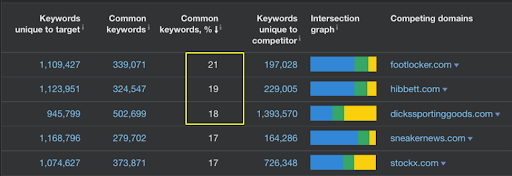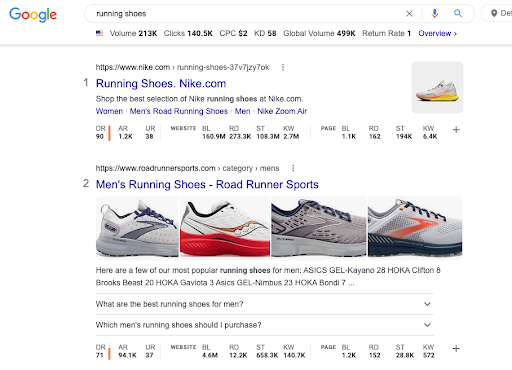Table of Contents
A Guide to SEO Competitor Analysis
In this post, we are going to cover concepts in regard to looking at competition from an SEO perspective. There are a number of ways to accomplish this and below are a few tried and trusted methods for understanding what your competitors are doing. There is much more to this than just adding competitors in a tool and seeing what similar words they are using. We hope that you find the following useful for building your SEO strategy.
Related Content:
What is an SEO competitor analysis?
This can be best described as a process that will provide insight into what other URLs are competing with yours. This means keywords, backlinks, content, and even geographical areas. Similar to identifying the best keywords to use for your business it is important to define your competitors through multiple elements.
How to identify SEO competitors
Search the SERPs For keywords that match yours or utilize your favorite tool; most of them can do competitive domain analysis on the fly. If you are a local business that serves a specific area then do a search “main keyword + city” and see what comes up, most of the time focusing on the top 5 URLs. After you have determined your final list, it is time to look for specific strengths on each site.
Below is a list of competitors related to a URL. We are seeing that there are between 18 – 21 intersecting keywords for the sites. In this case, we will just choose the top 3.
In this case, we used our URL as the base of competition research, but you can also choose the most valuable keyword for your business. At times this may be more important than ranking higher than sites with similar keyword structures.
The next part of the process is finding key elements that truly define these URLs as competitors. When you are provided with recommended competition from any tool you still should manually search in the SERPs to confirm. If the search intent and focus are indeed competitive with your end goal.
The benefit of the manual search is that you can adjust settings for local or regional areas to see what is coming up. It is also important to point out that when you are doing this to also perform multiple device searches. A result on mobile may be different than what users are seeing on desktop.
Questions to ask from an SEO Competitors Analysis:
- What type of results are showing up (ads, information graphs, people also ask)?
- What are the differences between desktop to mobile results?
- Are there any patterns in the titles in the SERPs (keywords, phrasing)
1. Review SEO Competitors For Content Gaps
Find out where there are opportunities in your current content strategy compared to your competitors? An example of this would be noticing the site we are examining here in our example is lacking content around “Running Shoes” when the top three competitors indeed do have this content. Moving this into our strategy could provide more exposure to the search landscape.
2. Keyword Strength in the SERPs
Find where your competition is showing up in the search results for your main focus keywords. This can be done by searching for the keyword specifically in your favorite tool or even placing the keyword of choice in Google search.
What we are seeing above is that when the term “Best Running Shoes” is searched these are the top-ranking URLs associated with that keyword. In our analysis, we could go through and see how each one of these pages is laid out, the amount of content, and other factors that could be driving the value of these pages.
3. Analyze SEO Competitors Backlinks Gaps
A good rule of thumb is to see where your competition is gathering their backlinks to strengthen the profile, and those will also become great resources for your initial outreach. A beneficial task would be to review the backlink profile from your top 3 – 5 competitors and look for any patterns in their do-follow links back to their sites and pages. If you notice that when comparing your backlink profile there are missing link resources you could develop an outreach strategy to present specific URLs from your site for backlinks.
4. Analyze SEO Competitors Content Types
Competitors may approach their content efforts differently depending on the strategy used. This could mean more informational content based around “running shoes” with our current example. They could also be using more of a product-focused content-heavy strategy where they are building up the actual running shoe product pages. If you are focusing on a specific keyword grouping for your competition research you may find that top results have a commonality to them. On the flip side to that, if you see an opportunity to improve what is already there by adding better features such as structured data, images, or other UX that could help you get in front of the current competition as well.
Strategic implementations from your SEO competitive analysis
Now that you have finished your research, what is next? Building out your strategy to fit the analysis. In our ongoing example here we are looking to find ways to improve our rankings for running shoes and varieties of that. We will need to set a priority list of what the competition is doing and what we are not.
For example:
- Build a backlink profile based on competitive research gaps (low)
- Search is filled with e-commerce options so having structured data around our products will be key (high)
- Informational content on what makes a great running shoe will assist in our efforts (medium)
- Authoritative content on how to pick quality running shoes and why it matters (high)
This is just an example but could be the starting point from the competitive research that we have conducted. To explain why the level of priorities is set we can see that creating content that will help people purchase and making sure product structured data is there will assist the most in search results. The backlinks could come naturally from our content efforts but could be an outreach post with the other items being completed.
Conclusion
This is a crucial part of SEO and marketing in general. It is not always going to be a task on the entire domain and could come down to a specific vertical or set of keywords you are approaching. In our example here we were looking into running shoes specifically and not shoes in general, but in the future, the client could ask to switch to another type of shoe. That means that the competition could change as well. On a final note, no matter the tools you are using it is amazing how much you can find out from manually exploring your competitors.
Search News Straight To Your Inbox
*Required
Join thousands of marketers to get the best search news in under 5 minutes. Get resources, tips and more with The Splash newsletter:


